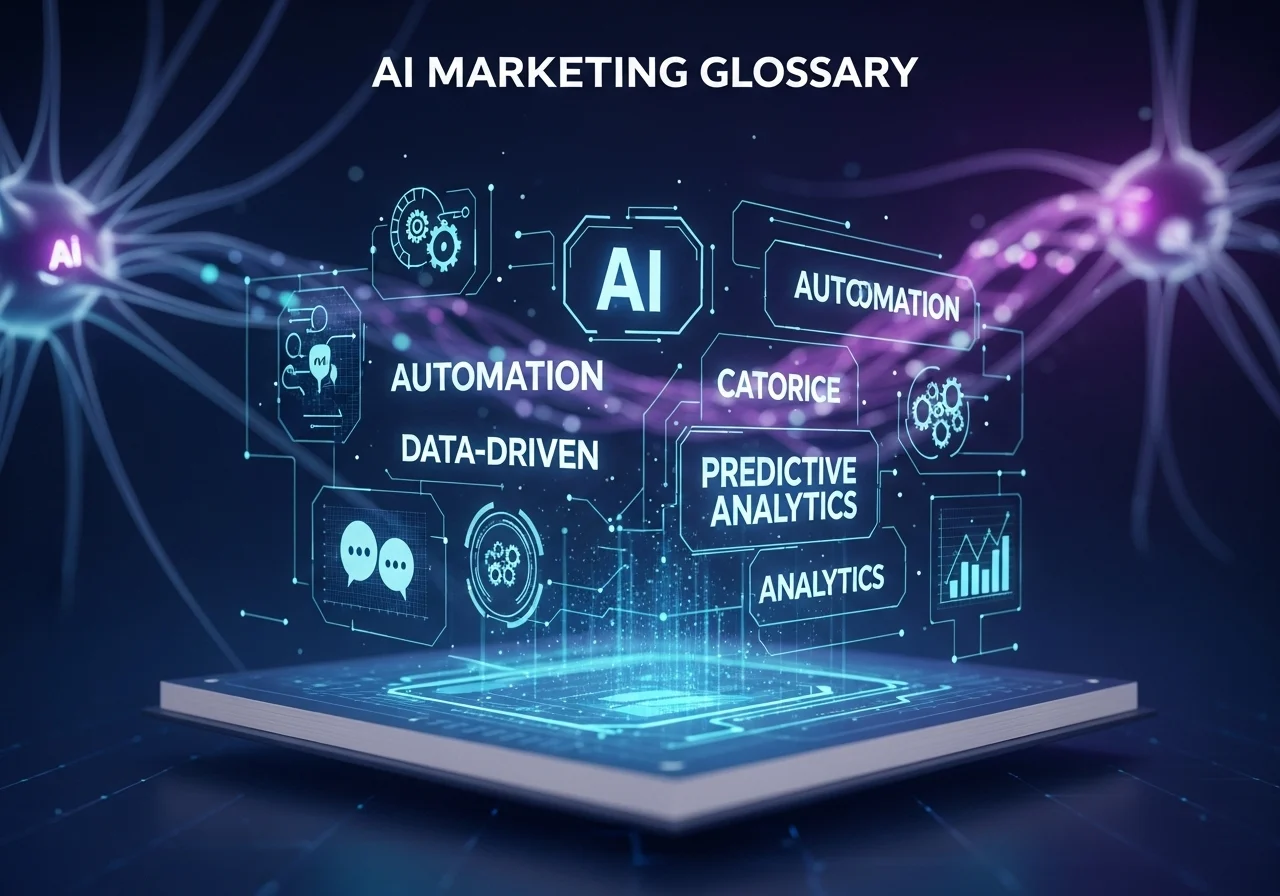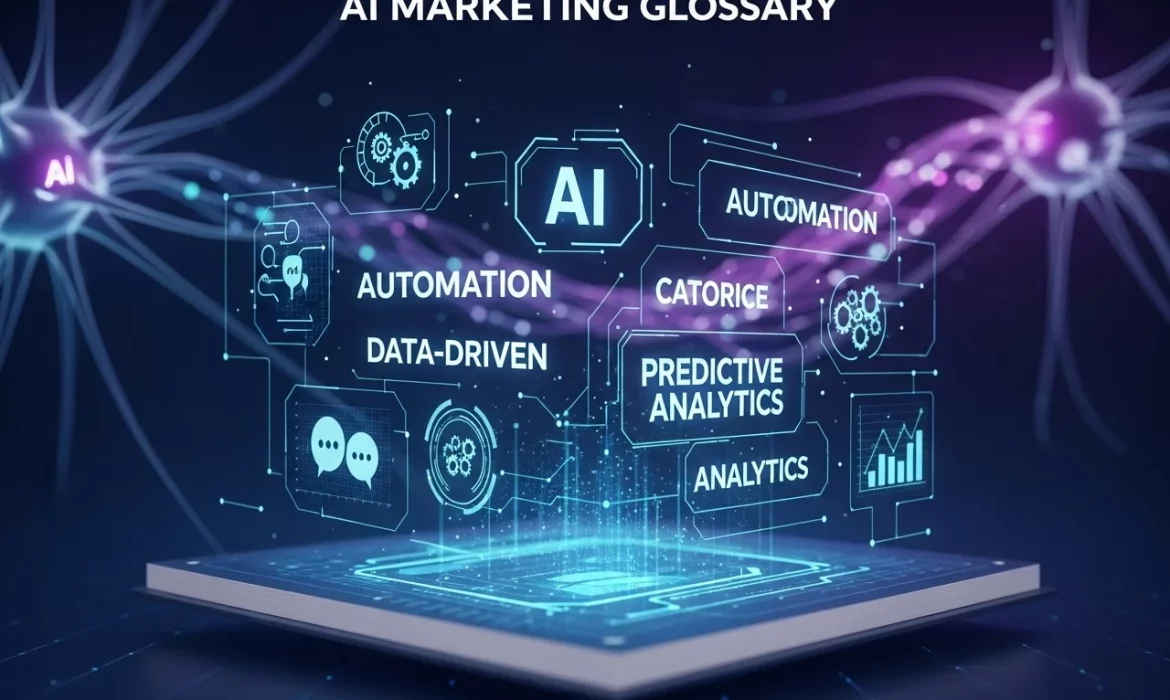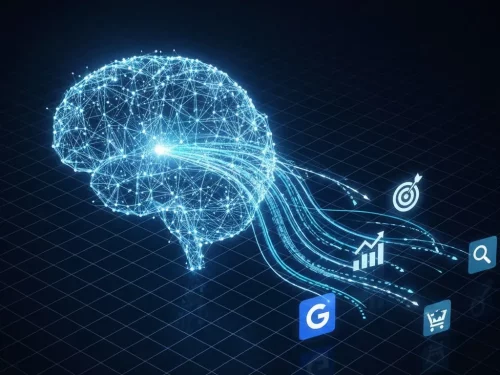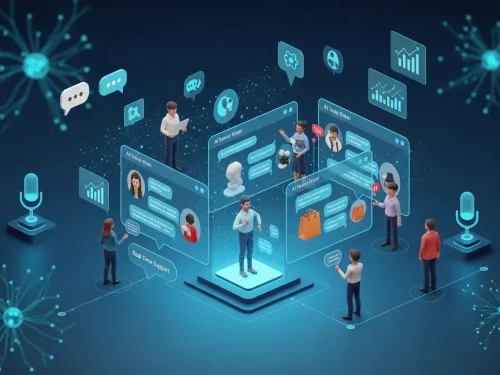Are you confused by the flood of AI marketing jargon? Every week, a new term surfaces, such as hyper-personalization, zero-party data, and so on.
Meanwhile, 88% of digital marketers rely on AI tools daily, but many struggle to speak the same language.

If you aim to lead rather than chase, you need clarity. Our glossary cuts through the noise with essential AI marketing terms explained clearly. Bookmark now to shape smarter strategies and stay ahead in 2025.
Why It’s High Time to Adapt These AI Marketing Terms?
The AI landscape shifts fast. Terms you learned months ago may already be obsolete. Stay current or fall behind.
96 % of marketers have partially or fully integrated AI into their strategies. Precise language matters more than ever. Misused jargon costs teams time and money. Clear definitions keep everyone aligned and campaigns on track. It also gives you a competitive edge.
Self‑study without a glossary ends in confusion. Ambiguous terms lead you down the wrong path. Wasted effort is the price of guesswork. This guide bridges that gap swiftly.
Vendors speak in AI dialect. You need to understand their terms before signing contracts. That way, you spot real innovations versus hype. Your clarity turns talks into action.
Classic Metrics, Supercharged by AI
You may already be familiar with those classic marketing metrics. AI turns them into precision engines. Expect faster insights and smarter decisions.
1. A/B Testing
A/B testing splits your page or ad into two or more versions to determine which one performs better.
AI keeps experiments running nonstop, shifting traffic to the best performer so you learn faster without manual tweaks.
2. Conversion Rate
The conversion rate monitors the percentage of visitors who take your desired action, such as signing up, downloading, or making a purchase.
AI analyses visitor behaviour, pinpoints the highest‑potential pages, and recommends tweaks that lift your numbers.
3. Click‑Through Rate (CTR)
CTR is a measurement metric that indicates how often viewers click on your ad or link after seeing it.
AI-driven dynamic creative optimization dynamically swaps headlines, images, and offers in real-time based on each user’s profile, serving the most compelling content every time.
4. Bounce Rate
Bounce rate reveals who leaves without engaging. AI‑powered heatmaps and session replays highlight exact friction points such as slow load times, confusing menus, or weak copy, so you can fix them before they drive traffic away.
5. Attribution Models
Attribution models assign credit across every touchpoint on the customer journey. AI‑driven models use data patterns to weigh each interaction, giving you a clear view of which channels actually drive revenue.
6. Audience Targeting
Audience targeting defines who sees your messages based on demographics, interests, or past behavior. AI refines those segments continuously by mining real‑time data and lifetime‑value signals, so you spend on the prospects most likely to convert.
7. Content Performance
Content performance measures how well your blog posts, videos, or social updates resonate with your audience. AI employs natural language processing and sentiment analysis to score topics and formats, guiding you to invest in ideas that truly engage.
Core AI Concepts
Build your foundation on these core pillars. They power every AI tactic you’ll deploy and help you cut through jargon with confidence.
8. Artificial intelligence (AI)
AI means machines thinking and learning like humans. In marketing, it drives personalization engines, bid optimizers, and automated workflows.
You rely on AI any time you see real‑time customer targeting or smart content recommendations.
9. Machine learning (ML)
ML uses data instead of hard‑coded rules to improve over time. It spots hidden patterns in user behavior and fine‑tunes campaigns without manual input.
When you test audiences or predict churn, ML is the force behind those decisions.
10. Deep learning
Deep learning layers neural networks to handle complex signals such as images or voice. It powers dynamic creative tests where visuals adapt to viewer preferences.
Voice search ads and image‑driven product recommendations all run on deep learning.
11. Natural language processing (NLP)
NLP lets machines read, interpret, and generate human language. Chatbots, sentiment analysis, and automated copywriting rely on NLP to sound natural.
Every time your email platform picks the most engaging subject line, NLP is at work.
12. Computer vision
Computer vision teaches AI to understand photos and videos. It drives visual search, automated product tagging, and performance testing of image‑based ads.
You tap into computer vision when you optimize ad creatives based on visual engagement data.
13. Transformer models
Transformer models are advanced architectures that grasp context in long‑form text.
They power modern chatbots, generate full‑length articles, and suggest headlines that resonate. Whenever you see coherent AI‑written copy, a transformer model made it possible.
14. Generative AI
Generative AI creates fresh text, images, or video from simple prompts. It scales your content engine, from draft blog posts to ad visuals, at lightning speed.
Whenever you run dynamic ads or personalized landing pages, generative AI is behind the scenes.
Advanced Frameworks & Architectures
Advanced frameworks and architectures power next‑generation AI features and fuel sophisticated campaigns.
15. AutoML
AutoML automates model building and tuning. You feed it raw data, and it selects the best algorithms, tunes parameters, and deploys models without manual pipelines. Non‑tech teams roll out custom AI in hours instead of weeks.
16. Reinforcement Learning
Reinforcement learning trains AI through rewards and penalties. It explores strategies by trial and error and optimizes decisions over time. Think bidding engines that learn to spend smarter with every auction.
17. Generative Adversarial Networks (GANs)
GANs pair a creator network with a critic network to generate hyper‑realistic synthetic content. The creator crafts images or videos, and the critic spots flaws, driving output toward ever‑higher fidelity for ads and visuals.
18. Transfer Learning
Transfer learning repurposes pre‑trained models for new tasks. You start with a model that already understands general patterns and fine‑tune it on your marketing data. That slashes development time and data needs dramatically.
Strategic Marketing Applications
AI moves from concept to campaign across content, personalization, prediction, creative optimization, and attribution.
19. AI‑Powered Content Creation
AI drafts headlines, articles, and ad copy from simple prompts. It scales your content engine without sacrificing brand voice, letting you test dozens of variations instantly.
20. Hyper‑Personalization
Hyper‑personalization tailors every message to individual behaviours and preferences. AI analyses real‑time data to serve the exact offer each visitor needs, boosting engagement and loyalty.
21. Predictive Marketing
Predictive marketing forecasts customer actions before they happen. Models crunch past interactions and external signals to score leads, predict churn, and pinpoint upsell opportunities.
22. Dynamic Creative Optimization
Dynamic creative optimization tests and swaps ad elements automatically. Your images, headlines, and calls to action rotate based on performance signals, keeping campaigns fresh and high‑impact.
23. AI Attribution Modelling
AI attribution modelling credits every touchpoint accurately. Algorithmic models analyze full customer journeys, showing which channels and campaigns drive real revenue.
Data & Privacy Fundamentals
Trustworthy AI marketing starts with clean data and strong privacy practices.
24. Data Readiness
Data readiness means auditing, cleaning, and structuring raw inputs. You remove duplicates, fix errors, and standardize formats so models learn faster and make better predictions.
25. Data Pipelines
Data pipelines automate flows from collection through transformation to storage. You eliminate manual handoffs, ensure fresh information, and reduce errors in every campaign.
26. Structured vs. Unstructured Data
Structured data fits neatly into tables. Unstructured data, like text, images, or audio, requires AI to extract value. Knowing the difference guides your tool choice and maximizes insights.
27. Zero‑Party Data
Zero‑party data is volunteered directly by customers, such as preferences, feedback, and intentions. It builds trust, powers precise personalization, and sidesteps privacy headaches.
Ethics & Governance
Ethical guardrails keep your AI honest and your brand protected.
28. Explainable AI (XAI)
XAI makes black‑box models transparent. You trace how inputs influence outcomes and justify decisions to stakeholders and regulators.
29. Responsible AI
Responsible AI embeds fairness, accountability, and privacy into every stage of development. You set guidelines, monitor for bias, and document processes to stay compliant.
30. AI Bias
AI bias arises when training data skews outcomes unfairly. You audit datasets, adjust training methods, and enforce fairness metrics to protect your reputation.
Future Tech & Operations
Emerging trends and operations practices shape tomorrow’s AI marketing toolkit.
31. Edge AI
Edge AI runs models on local devices instead of the cloud. You deliver instant insights, reduce latency, and cut bandwidth costs for real‑time personalization in apps and devices.
32. Retrieval‑Augmented Generation (RAG)
RAG combines live data retrieval with generative AI. Models pull in up‑to‑date information and produce accurate, context‑aware answers for chatbots and dynamic content.
33. MLOps
MLOps applies DevOps principles to machine learning workflows. You automate deployment, monitoring, and version control so models stay reliable and scalable over time.
Let’s Bring These Terms into Action
These terms spark ideas. But execution is everything. Partner with EvenDigit, a CMMI Level 5 agency with 12+ years of AI digital marketing mastery.
We’ve powered over 1,200 projects across Ecommerce, SaaS, healthcare, and beyond, achieving a 100% success rate. You get a personalized strategy and hands-on support at every step.
Our experts translate jargon into data-driven roadmaps and optimize campaigns in real-time. Ready to turn these concepts into real growth? Let’s build your smartest campaigns yet.
EvenDigit
EvenDigit is an award-winning Digital Marketing agency, a brand owned by Softude (formerly Systematix Infotech) – A CMMI Level 5 Company. Softude creates leading-edge digital transformation solutions to help domain-leading businesses and innovative startups deliver to excel.
We are a team of 70+ enthusiastic millennials who are experienced, result-driven, and hard-wired digital marketers, and that collectively makes us EvenDigit. Read More




